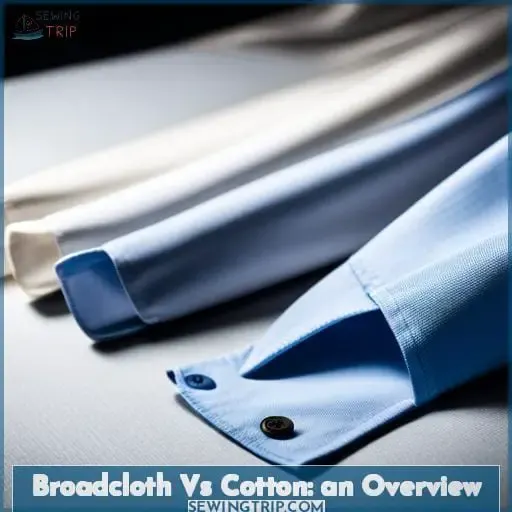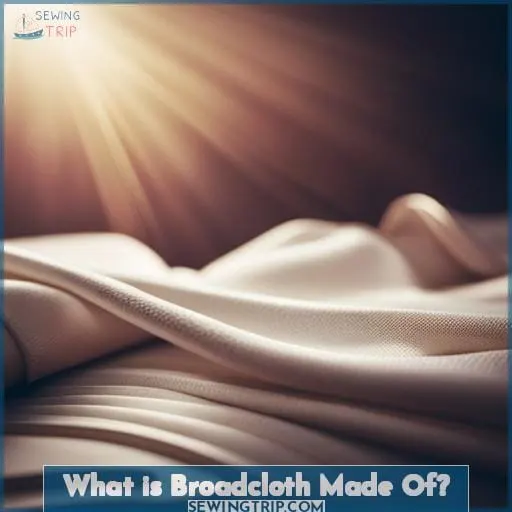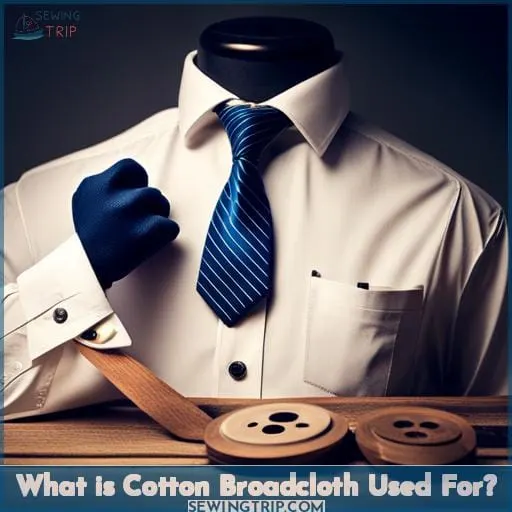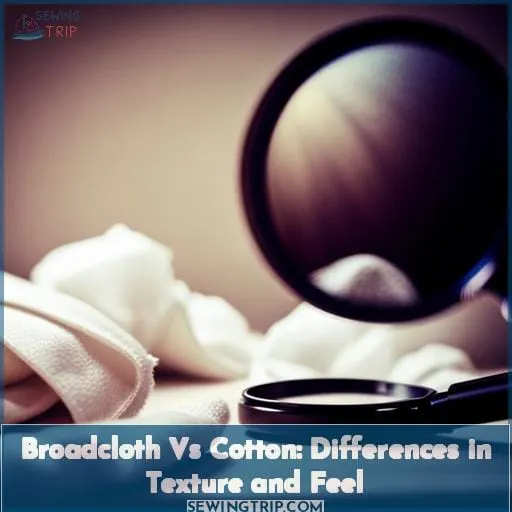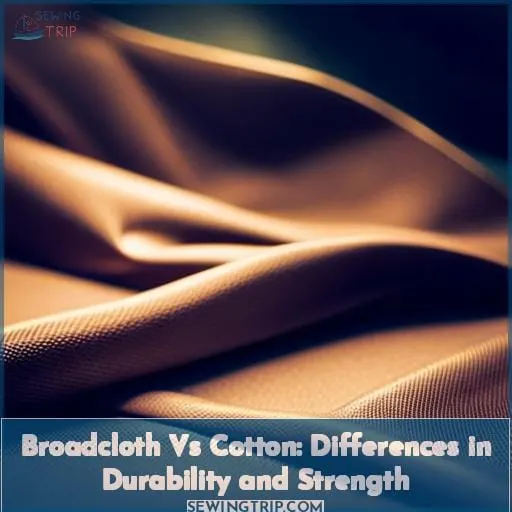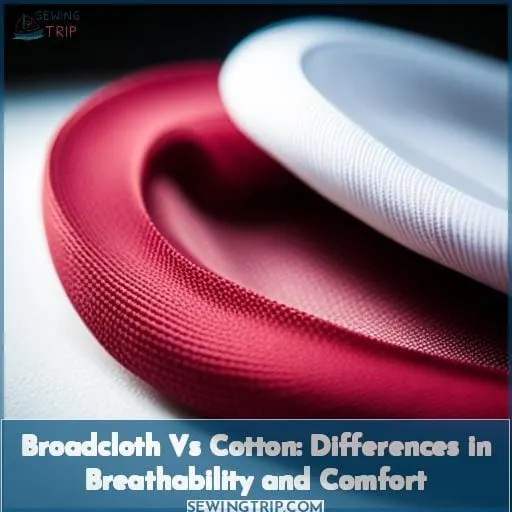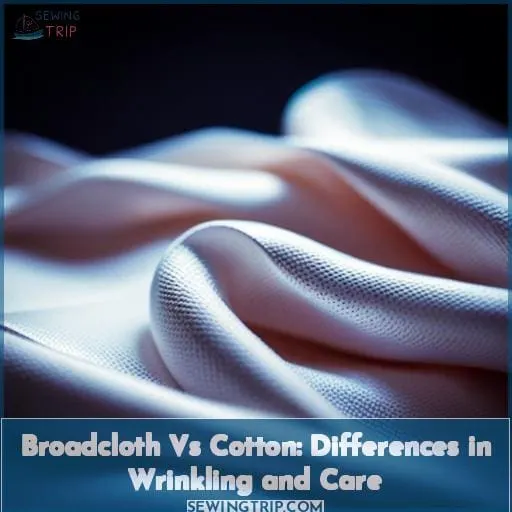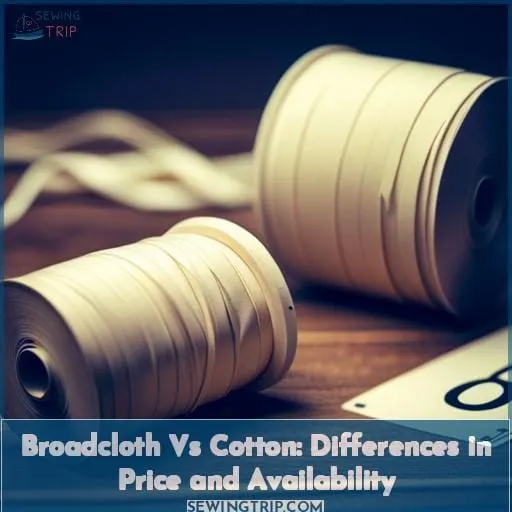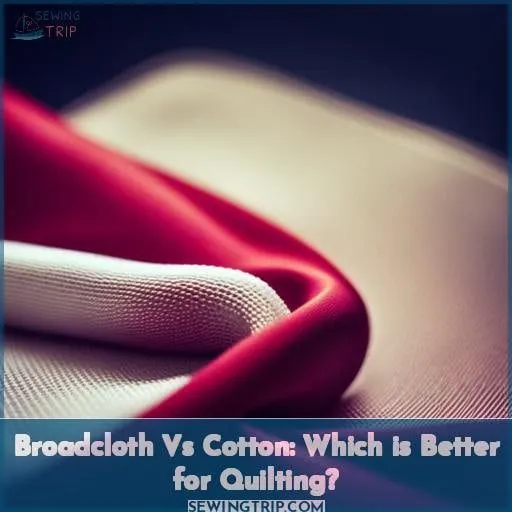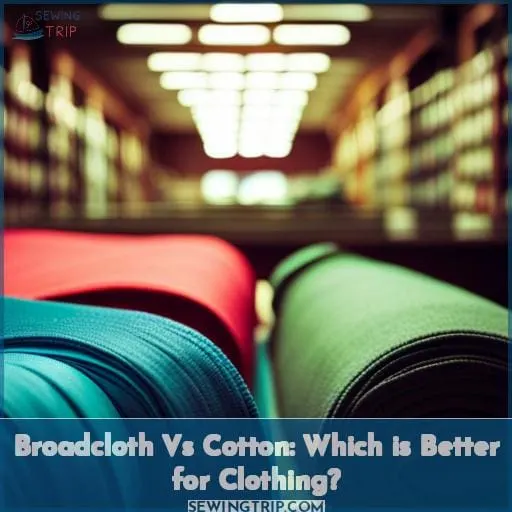This site is supported by our readers. We may earn a commission, at no cost to you, if you purchase through links.
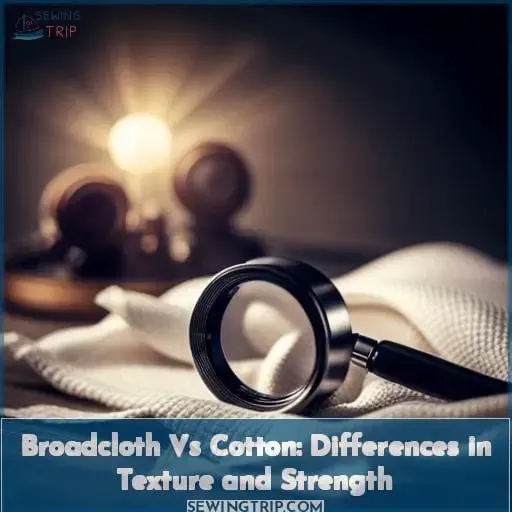 Imagine a world where you have the power to choose fabrics that perfectly suit your needs. In this world, understanding the differences between broadcloth and cotton is crucial.
Imagine a world where you have the power to choose fabrics that perfectly suit your needs. In this world, understanding the differences between broadcloth and cotton is crucial.
Broadcloth and cotton may seem similar at first glance, but their texture and strength set them apart. By delving into the intricacies of these fabrics, you can unlock a wealth of knowledge that will empower you to make informed decisions about your textile choices.
Get ready to discover the nuances between broadcloth vs cotton in terms of texture and strength – it’s time for liberation through fabric education!
Table Of Contents
- Key Takeaways
- Broadcloth Vs Cotton: an Overview
- What is Broadcloth Made Of?
- What is Cotton Broadcloth Used For?
- Broadcloth Vs Cotton: Differences in Texture and Feel
- Broadcloth Vs Cotton: Differences in Durability and Strength
- Broadcloth Vs Cotton: Differences in Breathability and Comfort
- Broadcloth Vs Cotton: Differences in Wrinkling and Care
- Broadcloth Vs Cotton: Differences in Price and Availability
- Broadcloth Vs Cotton: Which is Better for Quilting?
- Broadcloth Vs Cotton: Which is Better for Clothing?
- Frequently Asked Questions (FAQs)
- Conclusion
Key Takeaways
- Broadcloth is a versatile fabric made from wool and cotton, while cotton broadcloth is solely woven from cotton fibers.
- Both fabrics are medium-weight and suitable for various applications, including clothing, craftwork, and upholstery projects.
- Cotton broadcloth has excellent draping quality and is often used for shirts, skirts, dresses, linings, and upholstery.
- Broadcloth has a smooth and crisp texture, while cotton can range from soft to stiff. Cotton broadcloth offers good durability and tear resistance.
Broadcloth Vs Cotton: an Overview
When comparing broadcloth vs cotton, you may be wondering about the overall characteristics and distinctions between these two fabrics.
Broadcloth is a smooth and glossy fabric known for its plain weave and tight construction. It can be made from various materials such as wool, cotton, silk, polyester or rayon.
Cotton broadcloth, on the other hand, consists solely of woven cotton fibers.
In terms of weight and drape, both fabrics are versatile options with medium-weight properties that lend themselves well to different applications including clothing like shirts or skirts as well as craftwork or upholstery projects.
While broadcloth offers a more opaque texture compared to cotton’s natural transparency when held up against light sources; it also requires more ironing due to its tendency towards wrinkling whereas ironing is less needed with pure cotton fabric due to its inherent wrinkle resistance qualities.
What is Broadcloth Made Of?
Broadcloth is primarily crafted from wool and cotton, making it a versatile fabric with a combination of natural fibers that contribute to its unique characteristics. Over the years, broadcloth has evolved to include other materials such as silk, polyester, or rayon, though less common.
The historical significance of broadcloth dates back to its introduction in the US in the 1920s when it was modified into mercerized fabric.
Broadcloth comes in different types like wool-based or cotton-based varieties and can vary in weight depending on the composition of fibers used. Its properties include a smooth texture due to its plain weave construction and excellent durability for various applications like crafting upholstery or clothing items such as shirts and skirts.
Taking care of broadcloth involves considering factors such as thread count, weave type (including ply), and appropriate washing techniques for maintaining its quality over time.
- Broadcloth primarily consists of wool
- Cotton is another major component
- Other possible materials may be included
What is Cotton Broadcloth Used For?
Now that you have a clear understanding of what broadcloth is made of, let’s explore the various applications and uses of cotton broadcloth.
Cotton broadcloth is a versatile fabric known for its excellent draping quality, making it suitable for a wide range of purposes.
It can be used to create lightweight and comfortable shirts, skirts, and dresses that drape beautifully on the body. Additionally, cotton broadcloth is often utilized as linings in coats or bags due to its durability.
This fabric also finds application in upholstery projects where its smooth texture adds an elegant touch to furniture pieces. Moreover, quilters appreciate the versatility of cotton broadcloth as it provides them with endless possibilities when creating quilts.
For sewing enthusiasts like yourself, working with cotton broadcloth ensures ease during construction due to its lack of stretchiness.
Broadcloth Vs Cotton: Differences in Texture and Feel
To understand the differences in texture and feel between broadcloth and cotton, let’s delve into their distinct characteristics.
-
Drape:
- Broadcloth tends to have a crisp, smooth drape while cotton can vary from soft to stiff depending on weave and finish.
-
Wrinkling:
- The tight weave of broadcloth resists wrinkling better than looser cotton fabrics.
-
Stiffness and Smoothness:
- Broadcloth’s smooth, flat surface comes from its dense, stiff construction. Cotton can range from soft and flexible to crisp and stiff.
With its smooth, crisp hand and structured drape, broadcloth diverges from cotton’s wide spectrum of textures and feels – from light and soft to heavy and stiff. By investigating their distinct warp and weft constructions, we gain insight into how these textiles grace the body and environment differently.
Broadcloth Vs Cotton: Differences in Durability and Strength
When it comes to durability and strength, cotton broadcloth offers a reliable option for various sewing projects. Its tightly woven construction provides good abrasion and tear resistance for long-lasting wear.
Cotton also has decent elasticity to avoid permanent creases. However, 100% cotton’s water resistance is poor compared to blended broadcloth.
For enhanced durability, broadcloth woven with polyester or rayon is recommended, as evidenced below:
| Fabric | Abrasion Resistance | Tear Resistance | Elasticity | Water Resistance |
|---|---|---|---|---|
| 100% Cotton | Moderate | Moderate | Moderate | Poor |
| Cotton/Polyester Blend | Good | Good | Moderate | Moderate |
| Rayon/Cotton Blend | Very Good | Good | Good | Good |
The precise blend is key – a touch of synthetic fiber bolsters cotton’s durability while retaining its coveted softness.
Broadcloth Vs Cotton: Differences in Breathability and Comfort
Continuing from discussing the durability and strength of broadcloth and cotton, let’s now explore their differences in terms of breathability and comfort.
- Broadcloth tends to be less breathable compared to cotton due to its tighter weave. This can result in a feeling of trapped heat and moisture against the skin.
- Cotton, on the other hand, is more breathable as it allows air circulation through its looser weave. It promotes better ventilation, making it suitable for hot summer days.
- In terms of comfort, broadcloth offers a smooth texture that feels luxurious against the skin. However, some may find it less comfortable during warmer weather due to its lower breathability.
- Cotton provides excellent comfort with its softness and natural fibers that allow for better airflow. It’s highly preferred by those seeking maximum comfort throughout different seasons.
In conclusion,
cotton emerges as the winner when considering both breathability and overall comfort levels between broadcloth vs cotton fabrics
Broadcloth Vs Cotton: Differences in Wrinkling and Care
Several key differences exist between broadcloth and cotton regarding wrinkling and care, as you’ll find that cotton wrinkles more easily while broadcloth can require gentler washing.
Cotton fabric is prone to wrinkling due to its natural fibers, which have a tendency to crease and fold. On the other hand, broadcloth is less likely to wrinkle thanks to its tightly woven construction and blended composition.
When it comes to caring for these fabrics, cotton requires more ironing after washing in order to remove wrinkles, whereas broadcloth is more wrinkle-resistant and may need less ironing or even none at all.
Additionally, broadcloth tends to be more durable than cotton when it comes to wear and tear.
Broadcloth Vs Cotton: Differences in Price and Availability
If you’re shopping for fabric, one key factor to consider when comparing broadcloth and cotton is the differences in price and availability.
Broadcloth tends to be more expensive compared to cotton fabrics due to its higher quality and versatility.
Cotton, on the other hand, is widely available at a lower cost.
While both fabrics can be found in various stores and online platforms, broadcloth may be harder to find in certain regions or specialty shops.
When it comes to quilting projects specifically, cotton is often preferred as it provides better durability and ease of handling during sewing.
So if budget plays a significant role in your fabric selection process or if you’re looking for a wider range of options readily accessible, cotton may be the more practical choice over broadcloth.
Broadcloth Vs Cotton: Which is Better for Quilting?
Between broadcloth and cotton, cotton is the superior choice for quilting because of its softness, breathability, and ease of use.
Cotton fabric offers a gentle touch against your skin as you work on your intricate quilt designs.
Its breathable nature allows air to circulate through the layers, preventing overheating during long quilting sessions.
The lightweight feel of cotton makes it effortless to handle and maneuver while stitching together different pieces.
Additionally, pre-washed cotton ensures that shrinkage is minimized after washing your finished quilt project.
With its durability and strength combined with a smooth texture perfect for detailed stitching patterns, cotton emerges as the ideal fabric for achieving exceptional results in quilting projects that exude both beauty and functionality.
Broadcloth Vs Cotton: Which is Better for Clothing?
When choosing between broadcloth and cotton for clothing, consider the differences in texture and strength.
- Texture:
- Broadcloth has a smooth, glossy finish due to its tight construction, while cotton offers a softer feel.
- Drapeability:
- Broadcloth drapes well on the body, creating elegant folds and movement. Cotton tends to have less drape due to its stiffness.
- Strength:
- Broadcloth is known for its durability and ability to withstand regular wear without losing shape or integrity. Cotton may be more prone to tearing or stretching over time.
Considering these factors will help you determine which fabric suits your clothing needs best. If you value a sleek appearance with excellent drapeability, broadcloth might be your preferred choice. On the other hand, if comfort is paramount but at the expense of some sturdiness, cotton could be an ideal option for casual garments like t-shirts or loungewear.
Ultimately it all depends on personal preference and how you prioritize texture versus strength in your clothing choices.
Frequently Asked Questions (FAQs)
Can broadcloth be used for upholstery?
Yes, broadcloth can be used for upholstery due to its tight construction and durability. Its smooth, glossy texture adds a touch of elegance to furniture pieces while providing the strength needed for everyday use.
What is the recommended needle size for sewing with broadcloth?
For optimal results when sewing with broadcloth, it’s recommended to use a needle size of 90/14 or 100/ This ensures smooth stitching and prevents fabric damage, allowing you to unleash your creative power without any hindrances.
Is broadcloth suitable for making curtains?
Yes, cotton broadcloth’s durability, affordability, and array of colors make it an ideal choice for curtains.
Its medium weight drapes well.
When sewing, mind the grain and use a suitable needle and thread to avoid puckering.
With proper construction, cotton broadcloth curtains will enhance any room.
What are the advantages of sewing with broadcloth for beginners?
When you embark on your sewing journey with broadcloth, you unlock a world of possibilities.
This fabric is like a key to creativity, granting you the freedom to bring your designs to life with ease and precision.
How does broadcloth differ from quilter’s cotton in terms of quality?
Broadcloth, compared to quilter’s cotton, offers a lower quality due to its composition of polyester, silk, or cotton blends. Embrace broadcloth for an affordable alternative that still delivers durability and versatility in your sewing projects.
Conclusion
In the grand tapestry of fabric choices, understanding the nuances between broadcloth and cotton is essential.
Like two distinct patterns woven into the fabric of our lives, broadcloth and cotton each offer unique qualities.
Broadcloth, with its tight weave and smooth texture, is ideal for dress shirts and other formal attire.
On the other hand, cotton’s natural fibers provide breathability and softness, making it perfect for everyday clothing.
Whether you seek strength or comfort, broadcloth vs cotton presents a choice that empowers you to create a textile masterpiece tailored to your needs.

